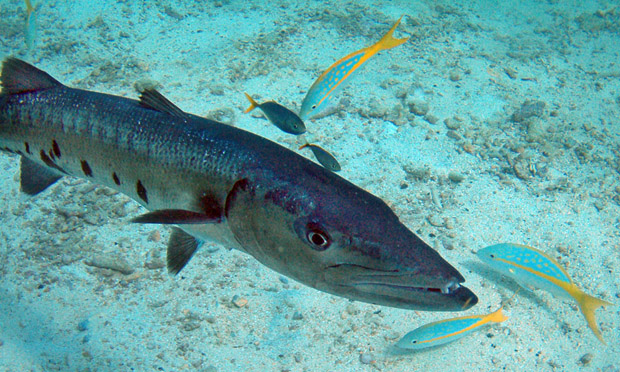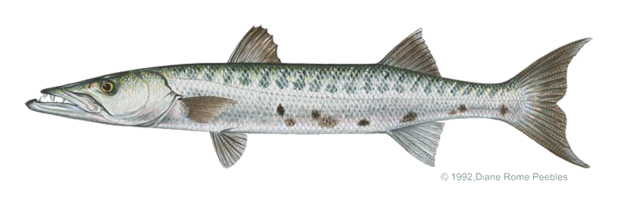A staff report
Barracuda
[dropcap]T[/dropcap]he barracuda ranges from North Carolina to South America to the Seychelles to the African coast – all tropical seas except the East Pacific. According the the International Game Fish Association (IGFA) there are two species of the Sphyraenidae Family or Barracuda, those being Guinean and Pacific.
The largest cuda caught (All-Tackle – IGFA world record) was in the neighborhood of 84-pounds (Seychelles).
Although they’re an aggressive predator, catching a big cuda isn’t all that easy on the flats. They, like all H2O dwellers spook, and a flats boat seen is a cuda gone. One of the best ways to catch them is wade fishing, but sharks have a bon appétit attitude for cudas and will stop at nothing to eat it.
Cudas hang offshore and inshore around reefs, piers, wrecks, points, sandy and grassy flats, and wherever smaller fish congregate. Smaller barracudas sometimes school, but the large ones are almost invariably loners.
They are always attracted to needlefish patterns – tube flies, but many an unexpected cuda hook-up has evolved when fishing for bones, permit and other species. They will eat small flies.
A good cast is worth a thousand words. An angler who can’t get a fly out 60- to 70-feet from the deck of a skiff is going to have a tough day on the flats fishing for cudas. In deeper water with sinking line, casting a shorter distance isn’t a fait accompli. Your guide will let you search cast around known areas where cudas are found.
A 9- or 10-weight will offer enough backbone for casting large flies and hooking a large critter. Not a bad idea to use clear fly lines. As for leader construction on the flats, go with a 9-foot and if you’re rigging to IGFA rules your class would be no less than 12-pound. Shorten your leader a little for casting big flies.
Cudas not only have long, sharp teeth but they’re serrated on the sides and can slice a finger to the bone with one swipe, thus a wire shock is needed. The wire bite guard can be solid or braided and should be at least 30-pound test. Most guides in the Florida Keys and Bahamas prefer single strand – solid. It’s best to tie your class to wire with a Albright because it works well with dissimilar diameter lines, and use a haywire to tie on the fly. The length of the wire shock causes a bit of a conundrum. If it’s 6-inches or longer your chances of getting bitten off are low, but your hook-up ratio falls noticeably when stacked up against a 3-inch long wire shock. That said, you’re going to lose more fish with the shorter shock. There doesn’t seem to be a middle ground.
Note: A cudas teeth can be very toxic so should you have a mishap with it’s teeth, clean the wound immediately and thoroughly.
You’ll need to bring long nosed pliers to safely extract a hook, thick work gloves (cudas are really slimy) and a small towel to clean with.
The drill
Cast your fly so it lands as softly as possible several feet away and directly in front of the cuda, not to the side – you want it to see your presentation with both eyes. Tuck the rod into your arm pit and use both hands to retrieve. To encourage it, start your retrieve slowly but erratically. When and if it gets interested, speed up the retrieve with steady overhand pulls and don’t stop until you know your hooked-up. If it doesn’t follow with intent to eat, retry. If it doesn’t sulk and move on, it may take a few redo’s to get it aggressively agitated.
Once hooked, the initial run will get your attention. The fight will not last long, but if it’s a 15-pound or more fish it will be capable of leaping 15-feet in the air – a remarkable sight A real thrill. Many times, just before launching, you’ll think for a second the fish is off, stay attentive and enjoy the show. When it’s at the gunnels the guide will be ready for your photo-op. Here’s where the industrial grade gloves, long nose pliers and towel come in. If you get to do the holding for the photo op don’t drop the cuda, all kinds of bad things could happen. Someone could get bitten and the skiff could get to be much older right away, and your guide? try pissed.
If your fishing over reefs or wrecks with full sinking fly line, the probability of hooking up with other species is high. Fish such as sails, jack crevalle, kingfish, yellowtail, snappers and even an amberjack. Site fishing on the flats is a best option if you want a cuda.






